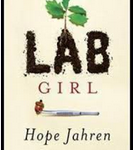Hope Jahren’s memoir “Lab Girl” abounds in a sense of place, both Jahren’s lab, where many of her stories are set, and some spectacular outdoor settings. Jahren is a geobiologist who studies plant behaviors as measured by the amount of carbon and other elements in their structures, and her fieldwork takes place all over the globe. (You can see a fantastic set of pictures here.) You may think you’re entering a description of a charmed life, but not so fast.
In “Roots and Leaves,” the first of three sections, Jahren describes her background and early life. Jahren grew up in Minnesota. Her great-grandparents migrated from Norway, and Jahren grew up in a Scandinavian culture where people didn’t talk much to each other over “vast emotional distances . . . forged early and reinforced daily.” Her three brothers are much older and “it was not unusual for us to go days and without finding anything to say to each other.” Jahren never met several of her mother’s many siblings, even though some lived in the same town. Jahren’s explains:
It must be a survival skill left over from the old Viking days, when long silences were required to prevent unnecessary homicides during the long, dark winters when quarters were close and supplies were dwindling.”
A self-deprecating tone punctuated with lacerating insights runs through the book. Jahren’s early training in English literature shows in her magnificent writing. She intersperses longer chapters about her life with shorter ones explaining an aspect of plant biology that then provides a metaphor. Jahren, for instance, sets off her description of the function of leaves – she describes them as an idea, “a vague genetic pattern with nearly endless room for improvisation” – against her recounting of her first major scientific find. Jahren’s thesis work was on hackberry trees, whose “berry is as hard as a rock–mainly because it is a rock.” Figuring out why that is so, and what building blocks it uses were the challenge. Once Jahren isolated the mineral she booked time in an x-ray diffraction lab to see if she could identify it.
In lesser hands what happened next might have been a self-aggrandizing story of triumph. Jahren begins with the observation: “I looked forward to my analyses with the same happy anticipation one brings to a baseball game: anything might happen, but it will probably take a long time.” Jahren made her discovery, and then some. It’s typical of the honesty of the book is that her real discovery that day was about herself:
In solving this mystery I had also proved something, at least to myself, and I finally knew what real research would feel like. But as satisfying as it was, it still stands out as one of the loneliest moments of my life. On some deep level, the realization that I could do good science was accompanied by the knowledge that I had formally and terminally missed my chance to become like any of the women that I had ever known.
In the second section, “Wood and Knots,” Jahren uses one hilarious but occasionally death-defying adventure after another to portray the long years of teaching and research as she established herself. There’s sexism and doubt among more senior scientists, but there’s also the developing relationship with her devoted lab partner, Bill. Jahren moved from California, where she did her graduate work, to Atlanta and then to Johns Hopkins to teach, scavenging equipment from the labs of retiring scientists and keeping it going thanks to Bill’s ingenuity and mechanical skills. It’s a tale of resourcefulness and making do, of field studies with students in tow and a great deal of hard work leavened with a great sense of humor.
One side trip meant a 7-hour detour to visit Monkey Jungle, a site near Miami that had been advertised on roadside billboards. The trip is recounted in detail (the long drive, the campout in the Monkey Jungle parking lot complete with police investigation). Once they got inside, the parallels were unmistakable:
Monkey Jungle was indeed a doppelganger for my lab . . . Three Java macaques that had been straining their brains over some problem that they could neither solve nor abandon propelled themselves toward us, supposing that we somehow represented an answer. A white-handed gibbon was draped limply across our walkway, either asleep or dead or someplace in between. Two small squirrel monkeys seemed to be trapped in their own private Samuel Beckett play, caught in a web made of equal parts dependence and loathing. In ironic proximity, two other squirrel monkeys were getting along very, very well by the looks of it.
There’s more – the eternal quest for funds, space, equipment, stability, students, and the continued development of the relationship with Bill. In the final section, “Flowers and Fruit,” Jahren talks about her life once she’s established herself and her lab. She married and had a child and she and her husband moved their family to Hawaii. Bill moved, too. Jahren returns again and again to her varied work with plants, and includes a plea to plant trees to preserve what we can of our environment. She explains that once a tree “exceeds the limitations of its environment, it loses all. And this is why you must trim a tree periodically in order to preserve it. Because–as Marge Piercy first said–both life and love are like butter and do not keep: they both have to be made fresh every day.
A good book about science that’s also wildly entertaining can be hard to come by. Don’t wait to read this one, and do let us know your favorite anecdote in the comments.
Have a book you want me to know about? Email me at asbowie@gmail.com. Follow me on Twitter @abowie917.



